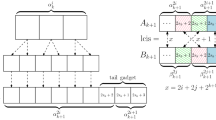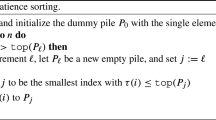Abstract
We derive fast algorithms for the problem of finding, on the real line, a prescribed number of intervals of maximum total length that contain at most some prescribed number of points from a given point set. Basically this is a typical dynamic programming problem, however, for input sizes much bigger than the two parameters we can improve the obvious time bound by selecting a restricted set of candidate intervals that are sufficient to build some optimal solution. As a byproduct, the same idea improves an algorithm for a similar subsequence problem recently brought up by Chen, Lu and Tang at IWBRA 2005. The problems are motivated by the search for significant patterns in certain biological data. While the algorithmic idea for the asymptotic worst-case bound is rather evident, we also consider further heuristics to save even more time in typical instances. One of them, described in this paper, leads to an apparently open problem of computational geometry flavour (where we are seeking a subquadratic algorithm) which might be interesting in itself.
Preview
Unable to display preview. Download preview PDF.
Similar content being viewed by others
References
Aggarwal, A., Suri, S.: Fast algorithms for computing the largest empty rectangle. In: Symp. on Comput. Geometry, pp. 278–290 (1987)
Agnarsson, G., Damaschke, P., Halldórsson, M.M.: Powers of geometric intersection graphs and dispersion algorithms. Discrete Applied Mathematics 132 (2003); Penttonen, M., Schmidt, E.M. (eds.) SWAT 2002. LNCS, vol. 2368, pp. 140–149. Springer, Heidelberg (2002)
Attalah, M.J., Fredrickson, G.N.: A note on finding a maximum empty rectangle. Discrete Applied Math. 13, 87–91 (1986)
Baran, I., Demaine, E., Patrascu, M.: Subquadratic algorithms for 3SUM. In: Dehne, F., López-Ortiz, A., Sack, J.-R. (eds.) WADS 2005. LNCS, vol. 3608, pp. 409–421. Springer, Heidelberg (2005)
Beger, R.D., Bolton, P.H.: Protein φ and ψ dihedral restraints determined from multidimensional hypersurface correlations of backbone chemical shifts and their use in the determination of protein tertiary structures. J. of Biomol. NMR 10, 129–142 (1997)
Chazelle, B., Drysdale, L.R.S., Lee, D.T.: Computing the largest empty rectangle. SIAM J. Comp. 15, 550–555 (1986)
Chen, Y.H., Lu, H.I., Tang, C.Y.: Disjoint segments with maximum density. In: Sunderam, V.S., van Albada, G.D., Sloot, P.M.A., Dongarra, J. (eds.) ICCS 2005. LNCS, vol. 3515, pp. 845–850. Springer, Heidelberg (2005)
Cornilescu, G., Delaglio, F., Bax, A.: Protein backbone angle restraints from searching a database for chemical shift and sequence homology (manuscript 1998), http://spin.niddk.nih.gov/bax/software/TALOS
Dor, D.: Selection algorithms, PhD thesis, Tel-Aviv Univ. (1995)
Edmonds, J., Gryz, J., Liang, D., Miller, R.J.: Mining for empty rectangles in large data sets. Theoretical Computer Science 296, 435–452 (2003)
Eppstein, D., Galil, Z., Giancarlo, R., Italiano, G.F.: Sparse dynamic programming I: Linear cost functions. J. of the ACM 39, 519–545 (1992)
Galil, Z., Park, K.: Dynamic programming with convexity, concavity and sparsity. Theor. Computer Science 92, 49–76 (1992)
Liu, B., Ku, L.P., Hsu, W.: Discovering interesting holes in data. In: 15th IJCAI 1997, pp. 930–935 (1997)
Mäkinen, V., Navarro, G., Ukkonen, E.: Algorithms for transposition invariant string matching. In: Alt, H., Habib, M. (eds.) STACS 2003. LNCS, vol. 2607, pp. 191–202. Springer, Heidelberg (2003)
Orlowski, M.: A new algorithm for the largest empty rectangle problem. Algorithmica 5, 65–73 (1990)
Paterson, M.S.: Progress in selection. In: Karlsson, R., Lingas, A. (eds.) SWAT 1996. LNCS, vol. 1097, pp. 368–379. Springer, Heidelberg (1996)
Ruzzo, W.L., Tompa, M.: A linear time algorithm for finding all maximal scoring subsequences. In: 7th Int. Conf. Intelligent Systems for Molecular Biology, pp. 234–241. AAAI, Menlo Park (1999)
Wang, Y., Jardetzky, O.: Probability-based protein secondary structure identification using combined NMR chemical-shift data. Protein Science 11, 852–861 (2002)
Xu, X.P., Case, D.A.: Probing multiple effects on 15 N, 13 C α, 13 C β and 13 C ′ chemical shifts in peptides using density functional theory. Biopolymers 65, 408–423 (2002)
Author information
Authors and Affiliations
Editor information
Editors and Affiliations
Rights and permissions
Copyright information
© 2005 Springer-Verlag Berlin Heidelberg
About this paper
Cite this paper
Bergkvist, A., Damaschke, P. (2005). Fast Algorithms for Finding Disjoint Subsequences with Extremal Densities. In: Deng, X., Du, DZ. (eds) Algorithms and Computation. ISAAC 2005. Lecture Notes in Computer Science, vol 3827. Springer, Berlin, Heidelberg. https://doi.org/10.1007/11602613_72
Download citation
DOI: https://doi.org/10.1007/11602613_72
Publisher Name: Springer, Berlin, Heidelberg
Print ISBN: 978-3-540-30935-2
Online ISBN: 978-3-540-32426-3
eBook Packages: Computer ScienceComputer Science (R0)




